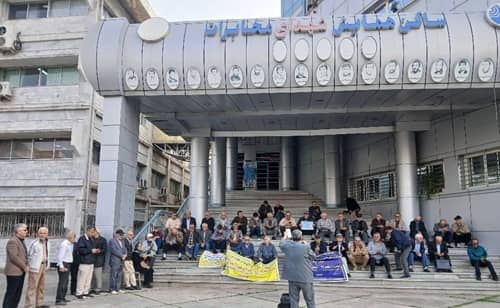
On Tuesday, November 18, 2025, a wave of protests swept across Iran, bridging the gap between economic grievances and high-stakes political defiance. From the streets of Tehran to the parched lands of Yasuj, diverse sectors of society—including oil workers, farmers, students, and the families of political prisoners—staged simultaneous demonstrations. The events of the day highlighted a deepening crisis of legitimacy for the regime, as citizens openly challenged the government’s mismanagement of natural resources and its ramped-up use of capital punishment.
“No to Execution”: A National Cry Against Suppression
The most politically charged demonstrations occurred in tandem with the “No to Execution Tuesdays” campaign, which marked its 95th week in 54 prisons. In solidarity with the prison strike, citizens held protests in dozens of cities, including Tehran, Isfahan, Mashhad, Shiraz, Tabriz, Rasht, and Ahvaz.
On Tuesday, families of death-row inmates gathered in front of government offices, breaking the regime’s imposed silence. In a striking display of courage, family members of death-row political prisoners Vahid Bani-Amerian and Pouya Ghobadi held portraits of their loved ones, demanding the annulment of their sentences.
Protesters were heard chanting slogans that directly challenged the regime’s authority, including “Death to the Dictator” and “The next execution triggers the uprising.” In one scene, the mother of prisoner Shahrokh Daneshvarkar stood before the crowd holding her son’s photo, crying out, “No to execution! Do not execute our children.”
“It Is Time for War”: The Water Crisis in the South
While political repression sparked protests in the capital, environmental devastation drove citizens in the southern provinces to the brink. In Yasuj, Kohgiluyeh and Boyer-Ahmad province, a large crowd of residents and students blocked Imam Hossein Square and gathered outside the provincial governor’s office to protest the construction of the illegal Khersan 3 and Mandegan dams.
The protesters view these IRGC-affiliated projects as the primary cause of environmental destruction in the Zagros region.
Simultaneously, in Shahr-e Kord, residents of the Ben and Saman counties gathered outside the governorate of Chaharmahal and Bakhtiari. They protested the regime’s refusal to allocate water rights, a policy that has led to the drying up of orchards and the destruction of the region’s agriculture.
Oil Strikes and Forty Years of Limbo
The country’s economic pulse continues to falter as unrest spreads within the critical oil sector. On November 18, retirees of the oil industry gathered outside the Ministry of Oil on Taleghani Street in Tehran, protesting the looting of their pension funds and the regime’s failure to adjust pensions to the soaring inflation rate.
Meanwhile, in the southwest, employees of the Abadan Oil Refinery held a protest at the company gates. These workers, hired through competitive exams in 2023, demanded fair implementation of pay scales and questioned why their base salaries remain far below the poverty line despite their official employment status. This follows a strike on Saturday, November 15, by workers of the Iranian Offshore Oil Company on Lavan Island, who demanded the removal of retirement caps and the independence of their pension fund from bankrupt state coffers.
Elsewhere, in Harsin, Kermanshah province, the incompetence of the state bureaucracy was laid bare. Residents gathered to protest regarding land in the Zaraliabad district. These citizens purchased the land over 40 years ago, yet the government has still refused to issue building permits, leaving families in a legal and economic limbo for four decades.
The events of November 18 paint a picture of a regime besieged by its own population. Whether the grievance is the drying of a river, the theft of a pension, or the execution of a dissident, the public’s anger is increasingly directed at the entirety of the ruling theocracy. As the regime responds with nooses and neglect, the resistance on the street only appears to be growing more resolute.




